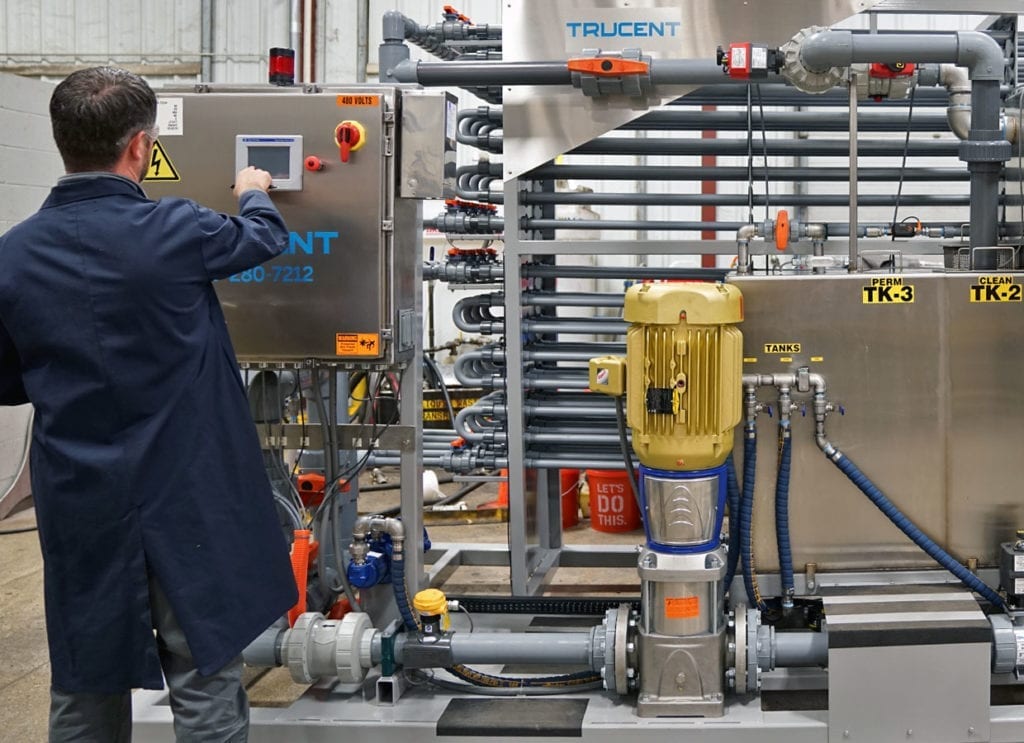Industrial Waste Water Treatment-- Eco-Friendly Solutions for Water Recycling
Wiki Article
Trick Techniques in Industrial Waste Water Treatment Procedures
The therapy of industrial wastewater is a vital facet of ecological management, involving a variety of methods created to minimize the impact of contaminants. Developments in innovations such as membrane layer purification and progressed oxidation procedures supply cutting-edge remedies for boosting therapy efficiency.Physical Therapy Approaches
Just how properly can physical therapy approaches resolve the intricacies of commercial wastewater? Physical therapy techniques play a critical function in the preliminary stages of wastewater management, focusing largely on the elimination of solids and huge particulates. Methods such as flotation protection, purification, and sedimentation are essential for reducing the focus of put on hold solids, consequently improving the efficiency of succeeding therapy processes.Sedimentation involves the gravitational settling of solids, permitting for the separation of larger materials from the wastewater. This approach is especially reliable in clearing up water prior to chemical or biological treatments.
Furthermore, flotation protection methods, which make use of air bubbles to lift put on hold solids to the surface area for removal, are reliable in treating wastewater with high focus of fats, oils, and oils. In general, physical therapy methods work as a vital initial step in the detailed management of industrial wastewater, making certain that the load on succeeding treatment stages is reduced and boosting overall treatment effectiveness.
Chemical Treatment Strategies
While physical treatment approaches prepared for effective wastewater monitoring, chemical treatment techniques are crucial for attending to the much more intricate pollutants often located in industrial effluents. These approaches utilize numerous chemical agents to precipitate, counteract, or oxidize damaging substances, making sure a more complete removal of contaminants.
One usual method is coagulation and flocculation, where chemical coagulants such as light weight aluminum sulfate or ferric chloride are added to advertise the gathering of suspended bits. This procedure enhances solid-liquid separation, lowering turbidity and improving water high quality. In addition, neutralization processes are utilized to readjust the pH of wastewater, making use of acids or bases to reduce the effects of acidic or alkaline streams, specifically.
Oxidation-reduction responses play an important duty in derogatory natural contaminants and microorganisms. Chemical oxidants like chlorine, hydrogen, or ozone peroxide are used to damage down intricate organic compounds, making them less damaging or extra biodegradable. Additionally, advanced oxidation processes (AOPs) integrate several oxidation strategies to boost toxin elimination efficiency.
Organic Therapy Procedures
The efficiency of wastewater treatment is substantially boosted by organic therapy processes, which harness the natural metabolic activities of microorganisms to break down raw material and remove pollutants. Industrial Waste Water Treatment. These procedures largely entail cardio and anaerobic food digestion, each customized for particular types of wastewaterAerobic therapy procedures use oxygen to support microbial growth, advertising the failure of natural contaminants into carbon dioxide and water. Usual techniques include activated sludge systems, where oygenation storage tanks help with the mixing of wastewater with microorganisms, and trickling filters, which urge biofilm growth on media surfaces.
Conversely, anaerobic therapy procedures take place in the absence of oxygen, making use of anaerobic germs to break down raw material, resulting in biogas manufacturing, a renewable resource resource. Anaerobic digesters are typically employed in commercial settings for this objective, successfully reducing the quantity of sludge while generating beneficial biogas.
The choice of an organic treatment approach depends on wastewater attributes, therapy goals, and regulatory requirements. The integration of organic processes in wastewater treatment not just enhances contaminant removal effectiveness but likewise promotes sustainability by minimizing chemical use and sustaining source recuperation.
Advanced Oxidation Processes

Usual AOP techniques consist of Fenton's ozonation, photocatalysis, and reagent. Fenton's reagent, a combination of hydrogen peroxide and ferrous iron, catalyzes the development of hydroxyl radicals, making it effective for treating wastewater consisting of phenolic compounds and various other recalcitrant compounds. Ozonation uses ozone as a powerful oxidant, qualified of deteriorating a vast array of natural toxins while concurrently decontaminating the effluent. Photocatalysis employs light-activated drivers, such as titanium dioxide, to enhance oxidation reactions and remove pollutants.
AOPs offer a number of advantages, consisting of decreased sludge manufacturing and the capability to treat wastewater with high concentrations of organic pollutants. The implementation of AOPs requires mindful factor to consider of functional parameters and cost-effectiveness, making certain that these sophisticated methods are appropriately integrated into existing wastewater therapy systems.
Membrane Purification Technologies

Microfiltration is effective for removing put on hold solids and bacteria, while ultrafiltration targets smaller sized organic particles and viruses. Nanofiltration additional reading links the space in between ultrafiltration and turn around osmosis, successfully eliminating divalent ions and natural substances. Reverse osmosis supplies the highest degree of filtration, made use of mainly for desalination and eliminating mono-valent ions.
Membrane layer technologies offer countless benefits, including low power intake contrasted to conventional therapy approaches, modular design for scalability, and the capacity for water healing and reuse. However, difficulties such as membrane layer fouling and the demand for routine upkeep should be addressed to ensure system effectiveness. Generally, membrane filtration innovations represent an important component of modern commercial wastewater treatment techniques, promoting sustainability and source preservation in water administration.
Conclusion
In conclusion, commercial wastewater therapy utilizes a varied array of methods, consisting of physical, chemical, biological, and advanced approaches. Continued improvements in these original site methodologies will better improve the effectiveness and performance of wastewater treatment processes in commercial setups.The therapy of industrial wastewater is an essential aspect of environmental monitoring, entailing a range of methods made to mitigate the effect of pollutants.Just how effectively can physical treatment techniques attend to the intricacies of commercial wastewater?Advanced oxidation processes (AOPs) stand for a sophisticated approach in industrial wastewater treatment, created to properly weaken natural pollutants that are frequently resistant to traditional treatment techniques (Industrial Waste Water Treatment).In final thought, industrial wastewater treatment utilizes a diverse range of methods, including physical, chemical, biological, and advanced methods. Continued advancements in these methodologies will certainly better improve the effectiveness and effectiveness of wastewater treatment processes in industrial settings
Report this wiki page